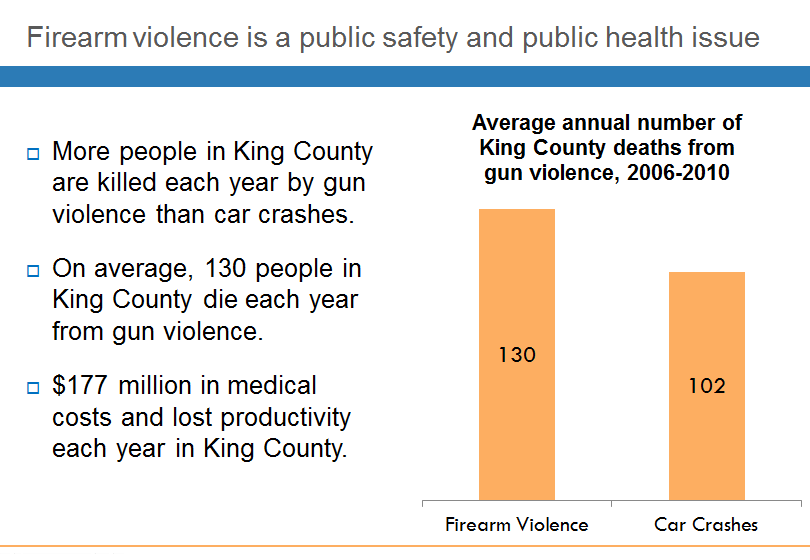Strategies for reducing firearm violence emerge from summit convened by Executive Constantine, Mayor Murray
Summary
More people in King County are killed each year by gun violence than car crashes. This summit created a common understanding of existing data that can be used for the development of strategies and actions to prevent firearm violence.
Story

More than 75 public health and safety experts developed a shared understanding of the data needed to treat gun violence as a preventable public health issue.
Several data-driven strategies for prevention of firearm violence emerged from a leadership summit of city, county, state, and federal agencies convened by King County Executive Dow Constantine and Seattle Mayor Ed Murray.
“Gun violence is a public safety crisis, but it is also a public health crisis,” said Executive Constantine. “We can approach it as a preventable public health problem and attack it through the kind of proven strategies that have reduced deaths from smoking, traffic crashes, and sudden infant death syndrome. We are taking the next step to confront this national epidemic.”
“Local jurisdictions must lead the way,” said Mayor Murray. “We’ve convened today’s summit to tackle firearm violence with the same data-driven decision-making we use to address other major challenges.”
The long-planned Firearm Violence Prevention Leadership Summit stems from a February 2013 directive from Executive Constantine to Public Health – Seattle & King County, calling for development of innovative, data-driven local strategies for preventing gun violence. Since the signing of that Executive Order, 262 firearm deaths have occurred in King County: 181 by suicide, 79 by homicide, and two by unintended means.
The meeting brought agency leaders together to develop a common understanding of existing data on firearm violence in King County, so they can develop and commit to data-driven strategies and actions.
Among the data presented at the summit:
- More than 130 people die each year in King County as a result of firearm use, meaning more people in King County are killed by gun violence than by car crashes.
- An estimated 26,500 households in King County store at least one firearm that is unlocked and loaded.
- 14 percent of King County high school students say it would be easy for them to get a handgun if they wanted.
- 68 children were lost to gun violence in King County from 1999-2012—two-thirds were murdered, and one-third died by their own hand because they could get hold of a firearm.
The experts included representatives from public health, law enforcement, hospitals, schools, the University of Washington, prosecutors, public defenders, suicide prevention, youth services, and others.
“Public Health implores households to unload and lock their firearms,” said Patty Hayes, Interim Director of Public Health – Seattle & King County. “We know what to do, and we can prevent injury and death.”
Public Health also works with firearm sellers and retailers to encourage safe storage of firearms through the public education campaign known as LOK-IT-UP (www.lockitup.org).
Some of the strategies and actions discussed at the summit:
- Youth violence prevention - Research shows that a person treated at the hospital for a gunshot wound is 30 times more likely to be shot again. Participants recommended increasing intervention by youth violence prevention practitioners with high-risk youth, especially after emergency room visits for gunshot wounds.
- Domestic violence prevention - A new law takes effect on Dec. 1, 2014, requiring the surrender of firearms by people who are the subject of no-contact, protection, and restraining orders. Participants identified the need for uniform training of police and judicial officers on implementation of the new law.
- Suicide prevention - Eighty-two percent of youth who died by firearm suicide used a family member's gun. Participants called for promotion of suicide awareness, including resources and outreach materials, for health care providers and schools, and for expansion with key partners of Suicide Death Reviews that go beyond the existing Child Death Review.
- Data sharing - Washington state will join 28 other states in the National Violent Death Reporting System, a database managed by the Centers for Disease Control and Prevention. Participants recommended increasing the number of King County law enforcement agencies that contribute data, and expanding data collection and reporting to track firearm injuries.
The Firearm Violence Prevention Leadership Summit included commitments among partners and experts for the 2015 calendar year. The Gun Violence Prevention Program, funded by Executive Constantine and Mayor Murray, will coordinate and facilitate these commitments.
Source: Public Health – Seattle & King County
Relevant links
- Firearm safety in King County (Public Health)
- LOK-IT-UP: Promoting the safe storage of firearms
- Gun violence research in King County
- Which firearm locking device is right for you? PDF
Quotes
Gun violence is a public safety crisis, but it is also a public health crisis. We can approach it as a preventable public health problem and attack it through the kind of proven strategies that have reduced deaths from smoking, traffic crashes, and sudden infant death syndrome. We are taking the next step to confront this national epidemic.
Local jurisdictions must lead the way. We’ve convened today’s summit to tackle firearm violence with the same data-driven decision-making we use to address other major challenges.
Public Health implores households to unload and lock their firearms. We know what to do, and we can prevent injury and death.
For more information, contact:
Chad Lewis, King County, chad.lewis@kingcounty.gov, 206-263-1250Jason Kelly, Seattle, Jason.W.Kelly@seattle.gov, 206-684-8379

 Translate
Translate


